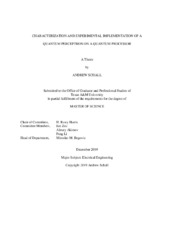| dc.contributor.advisor | Harris, Rusty | |
| dc.creator | Schall, Andrew | |
| dc.date.accessioned | 2020-09-11T15:46:54Z | |
| dc.date.available | 2021-12-01T08:45:29Z | |
| dc.date.created | 2019-12 | |
| dc.date.issued | 2019-11-13 | |
| dc.date.submitted | December 2019 | |
| dc.identifier.uri | https://hdl.handle.net/1969.1/189177 | |
| dc.description.abstract | Quantum computing and machine learning are both promising technologies that have seen rapid progress recently. However, the state of the art in these fields suggests it would be advantageous to combine both technologies to efficiently and elegantly extract the greatest degree of utility out of both. This work investigates a specific algorithm for a quantum perceptron, initially proposed by Yamamoto. This work covers the simulation and characterization of the quantum perceptron, novel implementation of quantum bias and physical implementation of the algorithm. Most simulations were run using the QuTiP python library and served to provide feedback and insight into the operation of the perceptron. This was especially important in lieu of a sophisticated training algorithm or rigorous mathematical models of the algorithm. Simulations were run to obtain relationships between inputs and outputs as weight values were changed. The bias was implemented via an auxiliary perceptron whose input value was independent of the input data values. This solves the null-input, null-output issue perceptron issue. However we found that implementing the bias in this manner greatly increases the dimensions of probability space in which the perceptron can perform calculations. Furthermore, this method gives access to data of how the algorithm would expand, specifically how one quantum perceptron would interact with another. As general-purpose quantum computers become more available to the public, testing theoretical architectures becomes possible. The maturing of the experimental aspect of this field allowed for the quantum perceptron to be tested on IBM’s Quantum Experience cloud platform.
Not only did this provide a second simulator with which to verify our theoretical results, more importantly, this gave access to a physical quantum computer to run the algorithm. Current generation quantum processors are noisy, losing information fidelity to the environment due to decoherence. This presented the challenge of designing lean quantum circuits to represent the algorithm in order that the information input into the processor would have the greatest chance of processing and accurately measured before it decays. Using this service, it is shown that the quantum perceptron is functional, practical and easily expandable on real quantum hardware. | en |
| dc.format.mimetype | application/pdf | |
| dc.language.iso | en | |
| dc.subject | Quantum Computing | en |
| dc.subject | Artificial Intelligence | en |
| dc.subject | Quantum Artificial Intelligence | en |
| dc.subject | Artificial Neural Network | en |
| dc.subject | Perceptron | en |
| dc.subject | Quantum Perceptron | en |
| dc.subject | IBM Quantum Experience | en |
| dc.title | Characterization and Experimental Implementation of a Quantum Perceptron on a Quantum Processor | en |
| dc.type | Thesis | en |
| thesis.degree.department | Electrical and Computer Engineering | en |
| thesis.degree.discipline | Electrical Engineering | en |
| thesis.degree.grantor | Texas A&M University | en |
| thesis.degree.name | Master of Science | en |
| thesis.degree.level | Masters | en |
| dc.contributor.committeeMember | Zou, Jun | |
| dc.contributor.committeeMember | Akimov, Alexey | |
| dc.contributor.committeeMember | Li, Peng | |
| dc.type.material | text | en |
| dc.date.updated | 2020-09-11T15:46:55Z | |
| local.embargo.terms | 2021-12-01 | |
| local.etdauthor.orcid | 0000-0003-3103-6623 | |


